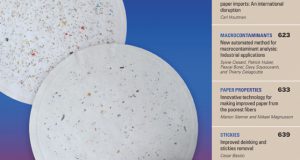MARCELO RIBEIRO
The primary organic contaminant in the pulping process is pitch. Pitch reduces pulp mill efficiencies and productivity from the washers through to the pulp dryer. Talc, an inorganic adsorbent, is the most common treatment for pitch control. Talc can cause scaling on evaporators, and is generally applied after brownstock washing.
Yet talc has been raised as a health concern in personal care products, and its use is monitored by producers of pulp for fluff, tissue, and toweling. The application of talc is dusty, requires dispersion equipment, and demands additional attention from operations personnel. Overuse of talc can also damage machine clothing by accelerating wear.
Archroma has developed a novel treatment for pitch control utilizing an organic adsorbent. Cartaspers PLH liquid eliminates pitch without talc, and minimizes the impact on other process variables (see sidebar). This article details the use of Cartaspers PLH liquid in a mill application, comparing the performance of the product to talc.
MILL APPLICATION
A mill located in Brazil had pitch issues due to high system closure. The plant characteristics before introduction of Cartaspers PLH liquid were as follows:
• Kraft low solids cooking process
• Kappa 17
• 100 percent eucalyptus hardwood
• DD Washers
• 4.5 kg/t talc divided in two addition points, after O2 delignification, and after Ep Stage
After performing an in-mill laboratory study, the mill introduced Cartaspers PLH liquid at filtrate of press post oxygen delignification at dosage rate of 300 g/adt. The filtrate is used to wash pulp in the previous washer stage, and adjusts stock consistency to the DD Washer located prior to the oxygen reactor. Using a counter current washing system, pitch is sent to the digester and consequently purged out to the evaporation plant. A summarized flow sheet is shown in Fig. 1.

Fig. 1: Flow sheet of pulp plant with Cartaspers PLH.
A second addition point was introduced at the Ep Stage to guarantee removal of any residual pitch that may be extracted. Dosage at this point was 150 g/adt.
Colloidal pitch counts showed a significant drop. Figure 2 and Fig. 3 present results of colloidal pitch counts on range of 60 days, split 30 days with talc, and 30 days with Cartaspers PLH liquid.

Fig. 2: Graph of colloidal pitch counts—Digester and 1st DD Washer.

Fig. 3: Graph of colloidal pitch counts—Post O2, Ep and D stages.
The application of Cartaspers PLH liquid was effective in controlling pitch in the pulp mill. The customer was able to guarantee pulp performance with colloidal pitch counts, which were below the control (prior to the application of Cartaspers PLH liquid). Ultimately, the reduction in ash of the cellulose was verified and the cost of application was 25 percent lower compared to the talc. These results obtained on an industrial scale allow the following conclusions:
• Lab work demonstrated that 0.45 g/t of Cartaspers PLH liquid replaced 5.0 kg/t of talc, a ratio of 1:11.
• The mill application validated the ratio, with 450 g/adt of Cartaspers PLH liquid versus 4.50 kg/adt of talc, a 1:10 ratio. Quality was maintained at normal levels.
• With Cartaspers PLH liquid, pitch counts were significantly lower, enabling future optimization, and total cost reduction was achieved.
ADVANTAGES OF ORGANIC PASSIVATION
The process of organic passivation with Cartaspers PLH liquid offers many benefits, including:
• The product is a water-based emulsion, delivered ready to use, requiring a simple metering pump and no makedown equipment or dry handling system. It provides a safe, dust-free environment for pulp mill employees. It is organic, contains no aluminum or metal ions, and contributes no ash in the pulp.
• Use of an alternative eliminates the health concerns that are associated with talc in the personal care industry, which is especially important in pulp applications for tissue, toweling, and fluff pulp.
• The extremely high surface area due to over 20 trillion particles per gram of Cartaspers PLH liquid enables a significant passivation effect with only 1/8th to 1/10th of the volume of dry talc.
• The hydrophilic molecule is uniquely engineered with a high Tg hydrophobic polymer that has an extremely strong attraction and affinity for pitch.
• Cartaspers PLH liquid is much smaller than pitch and covers the particle like a shell, eliminating the tackiness of the pitch. It also creates a protective layer on existing pitch deposits in the system and prevents further agglomeration of new particles to the deposit. It will not cause existing organic and pitch deposits to break loose.
• The product is non-abrasive, and will not decrease the life of paper machine fabrics.
• The low addition rate of Cartaspers PLH liquid is cost-effective, with it being applied at 1/8th to 1/10th (as received) that of talc on a dry basis. The proper dosage can be determined with laboratory work in the mill.
• Cartaspers PLH liquid complies with BfR recommendations XIV and XXXVI and is compliant with the Code of Federal Regulations (FDA) Chapter 21. Part 176.170 and 176.180.
In conclusion, Cartaspers PLH liquid presents several advantages over other passivation methods, improving pulp mill efficiency, contributing to product quality, and providing a safer work environment for employees. As usage levels are low, it can provide an application cost benefit as well.
Marcelo Ribeiro is global head of product management for process chemicals, Archroma. He can be reached at [email protected]. To learn more, contact your Archroma representative, or visit www.archroma.com.
How it Works
Cartaspers PLH liquid controls pitch by acting as a liquid synthetic adsorbent, which is differentiated with many advantages over conventional talc and dispersant treatments. Cartaspers PLH liquid is delivered as a water-based emulsion, requiring no makedown or dry handling. When dried, Cartaspers PLH is non-film forming and has no tack due to its extremely high Tg. The active mechanism of the product occurs when the Cartaspers PLH particles associate with hydrophobic pitch particles and raise the Tg of the pitch, reducing or eliminating its tackiness. The pitch is passivated, thus preventing the formation of pitch deposits. Because Cartaspers PLH liquid can be added at the brown stock washers, the passivated compound is removed from the process.
Figure 4 illustrates the main components of Cartaspers PLH liquid:
• Hydrophobic chain polymer is attracted to pitch particles. The high Tg of polymer shell increases the point at which the pitch particles soften, thus reducing coalescence.
• Hydrophilic groups maintain the bound pitch and polymer in a colloidal particle that is stable in the liquid phase, preventing agglomeration.

Fig. 4: Component parts of Cartaspers PLH liquid.
Cartaspers PLH liquid has strong affinity for nonpolar (hydrophobic) surfaces, i.e. pitch or stickies particles. Once adsorbed, the particles become hydrophilic in nature, and slightly anionic, promoting dispersion and preventing agglomeration. The high Tg of the polymer shell increases the softening point of the particles, reducing coalescence.
This principle of passivation with a Cartaspers PLH liquid is similar to the use of talc, but with critical differences. Cartaspers PLH liquid particles are much smaller than talc, with more than 20 trillion particles per gram of dry product, delivering an extremely high surface area for the typical addition level of 1/8th to 1/10th the dose of talc. The extremely small particle size and huge surface area per kilogram of Cartaspers PLH liquid versus talc means greater efficiency. Colloidal pitch particles are completely covered by Cartaspers PLH liquid, preventing any agglomeration.
 Paper 360
Paper 360


